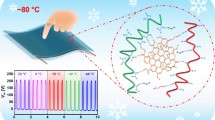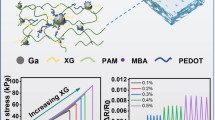Abstract
The high integration and multifunctionality in flexible electronic device play an important role in its development. In this study, we developed multifunctional hydrogels integrated with supercapacitive, photoelectric, and strain-sensing capabilities. The hydrogel composite consists of PAM/PVA matrix with polyaniline (PANI) and reduced graphene oxide (rGO) as conductive components. Two different acid dopants, citric acid (CA) and hydrochloric acid (HCl), were employed to investigate their impact on photoelectrochemical capabilities of hydrogels. Both CA-doped and HCl-doped hydrogels exhibited remarkable supercapacitive performance, achieving areal capacitances of 492 mF/cm2 and 538 mF/cm2, respectively. Furthermore, both hydrogels demonstrated photosensitivity towards shorter wavelengths such as ultraviolet (380 nm) and blue (475 nm) light. Lastly, the proposed hydrogels serving as highly sensitive strain sensors was verified through effectively sensing arm bending movements.












Similar content being viewed by others
Data availability
The data will be available upon request to the corresponding author.
Reference
Heng W, Solomon S, Gao W (2022) Flexible electronics and devices as human-machine interfaces for medical robotics. Adv Mater 34(16):2107902
Tai Y et al (2015) A highly sensitive, low-cost, wearable pressure sensor based on conductive hydrogel spheres. Nanoscale 7(35):14766–14773
Tai Y, Lubineau G (2017) Flexible nanodevices: “Self-Peel-Off” transfer produces ultrathin polyvinylidene-fluoride-based flexible nanodevices. Adv Sci 4(4):1600370
Shin SR et al (2018) Soft robots: Electrically driven microengineered bioinspired soft robots. Adv Mater 30:1870067
Kim K, Kim B, Lee CH (2020) Printing flexible and hybrid electronics for human skin and eye-interfaced health monitoring systems. Adv Mater 32(15):1902051
Chen L et al (2020) Ultrasensitive and robust two-dimensional indium selenide flexible electronics and sensors for human motion detection. Nano Energy 76
Zhu S et al. An artificial remote tactile device with 3D depth-of-field sensation. Sci Adv 8(43):eabo5314
Li J et al (2023) Bionic multifunctional ultra-linear strain sensor, achieving underwater motion monitoring and weather condition monitoring. Chem Eng J 464
Hu L et al (2023) Hydrogel-based flexible. Electronics 35(14):2205326
Zhang Y et al (2023) Hydrogels for flexible electronics. ACS Nano 17(11):9681–9693
Rong Q, Lei W, Liu M (2018) Conductive hydrogels as smart materials for flexible electronic devices. Chem Eur J 24(64):16930–16943
Guo X et al (2022) Application of conductive polymer hydrogels in flexible electronics. J Polym Sci 60(18):2635–2662
Nguyen VQ, Ahmed AS, Ramanujan RV (2012) Morphing soft magnetic composites. Adv Mater 24(30):4041–4054
Du W et al (2021) Injectable nanocomposite hydrogels for cancer therapy. Macromol Biosci 21(11):2100186
Li K et al (2020) Ternary hydrogels with tunable mechanical and self-healing properties based on the synergistic effects of multiple dynamic bonds. J Mater Chem B 8(21):4660–4671
Karamzadeh Y, Ansari Asl A, Rahmani S (2020) PCL microsphere/PEG-based composite hydrogels for sustained release of methadone hydrochloride. J Appl Polym Sci 137(33):48967
Li L et al (2022) Double network hydrogels for energy/environmental applications: challenges and opportunities. J Mater Chem A 10(17):9215–9247
Liu C et al (2023) Self-healing, antibacterial, and conductive double network hydrogel for strain sensors. Carbohydr Polym 303
Li G et al (2022) Highly conducting and stretchable double-network hydrogel for soft bioelectronics. Adv Mater 34(15):2200261
Li S et al (2020) Bifunctional polyaniline electroconductive hydrogels with applications in supercapacitor and wearable strain sensors. J Biomater Sci Polym Ed 31(7):938–953
Tao Y et al (2021) TiO2/PANI/Graphene–PVA Hydrogel for Recyclable and Highly Efficient Photo-Electrocatalysts. Ind Eng Chem Res 60(28):10033–10043
Gao Y, Jia F, Gao G (2019) Transparent and conductive amino acid-tackified hydrogels as wearable strain sensors. Chem Eng J 375:121915
Tao Y et al (2014) Supramolecular self-assembly of three-dimensional polyaniline and polypyrrole crystals. Chem Commun 50(84):12757–12760
Tao Y, Wang G, Zhu J (2015) Nanorods and nanoblocks of polyaniline and their solvent resistance. Russ J Phys Chem A 90(1):183–186
Tao Y et al (2015) A general route to 2D nanoleaves and nanoplates of polyaniline. Russ J Phys Chem A 89(12):2267–2270
Meng Y et al (2013) Hierarchical porous graphene/polyaniline composite film with superior rate performance for flexible supercapacitors. Adv Mater 25(48):6985–6990
Zhang QE et al (2017) Degradation-induced capacitance: a new insight into the superior capacitive performance of polyaniline/graphene composites. Energy Environ Sci 10(11):2372–2382
Neelgund GM, Bliznyuk VN, Oki A (2016) Photocatalytic activity and NIR laser response of polyaniline conjugated graphene nanocomposite prepared by a novel acid-less method. Appl Catal B 187:357–366
Parveen N et al (2016) Enhanced electrochemical behavior and hydrophobicity of crystalline polyaniline@graphene nanocomposite synthesized at elevated temperature. Compos Part B: Eng 87:281–290
Cao X et al (2021) Recent progress in multifunctional hydrogel-based supercapacitors. J Sci: Adv Mater Devices 6(3):338–350
Sun X, Yao F, Li J (2020) Nanocomposite hydrogel-based strain and pressure sensors: a review. J Mater Chem A 8(36):18605–18623
Huang R et al (2023) Near-infrared light-responsive hydrogels for highly flexible bionic photosensors. 23(9):4560
Wang K et al (2015) Chemically crosslinked hydrogel film leads to integrated flexible supercapacitors with superior performance. Adv Mater 27(45):7451–7457
Li J et al (2010) Synthesis and thermoelectric properties of hydrochloric acid-doped polyaniline. Synth Met 160(11):1153–1158
Niu M, Kong X (2015) Efficient biodiesel production from waste cooking oil using p-toluenesulfonic acid doped polyaniline as a catalyst. RSC Adv 5(35):27273–27277
Ansari MO, Mohammad F (2011) Thermal stability, electrical conductivity and ammonia sensing studies on p-toluenesulfonic acid doped polyaniline:titanium dioxide (pTSA/Pani:TiO2) nanocomposites. Sens Actuators B Chem 157(1):122–129
Kong P et al (2019) Conjugated HCl-doped polyaniline for photocatalytic oxidative coupling of amines under visible light. Catal Sci Technol 9(3):753–761
Li L et al (2014) Enhanced cycling stability of lithium sulfur batteries using sulfur–polyaniline–graphene nanoribbon composite cathodes. ACS Appl Mater Interfaces 6(17):15033–15039
Zhang Y et al (2021) Two kinds of polyaniline fiber photo sensor with interdigital electrode and flexible hydrogel. J Appl Polym Sci 138(26)
Tao Y et al (2020) Two functional nanofibers of polyaniline with application in supercapacitor and photosensor. J Nanoelectron Optoelectron 15(2):291–300
Acknowledgement
This work was supported by Anhui Primary Research and Development Program (1704e1002215), Natural Science Foundation of Anhui Province (1608085MB25), Postdoctoral Science Fund of Anhui Province (2016B108), National Natural Science Foundation of China (62071459), National Key Research and Development Program of China (2022YFF1202500, 2022YFF1202502), International Science and Technology Cooperation of Guangdong Province (2022A0505050058), the Science and Technology program of Guangdong province (2022A0505090007) and Foundation of Shenzhen (KQTD20210811090217009, JCYJ20220818101205011), GuangDong Basic and Applied Basic Research Foundation (2022A1515110080).
Funding
GuangDong Basic and Applied Basic Research Foundation, 2022A1515110080, Shanshan Zhu, National Natural Science Foundation of China, 62071459, Yanlong Tai, National Key Research and Development Program of China, 2022YFF1202500, Yanlong Tai, 2022YFF1202502, Yanlong Tai, International Science and Technology Cooperation of Guangdong Province, 2022A0505050058, Yanlong Tai, the Science and Technology program of Guangdong province, 2022A0505090007, Yanlong Tai, Foundation of Shenzhen, KQTD20210811090217009, Yanlong Tai, Foundation of Shenzhen, JCYJ20220818101205011, Yanlong Tai, Anhui Primary Research and Development Program, 1704e1002215, Yulun Tao, Natural Science Foundation of Anhui Province, 1608085MB25,Yulun Tao, Postdoctoral Science Fund of Anhui Province, 2016B108, Yulun Tao.
Author information
Authors and Affiliations
Contributions
Shuo Li: Gathering data, conducting research, and composing the initial draught; Yulun Tao: Conceptualization/theoretical guidance, financial assistance; Yuannan Wu: Offer early text draughts; writing-reviewing. Shanshan Zhu: Conceptualization/theoretical guidance, writing-reviewing Sara Khademi: Language polishing; Yinru lv: Experiment, data-processing, writing-reviewing; Chaoran Wang: Sample preparation, writing-reviewing; Yanlong Tai: Conceptualization/theoretical guidance, writing-reviewing, financial assistance.
Corresponding authors
Ethics declarations
Ethical approval
No ethical approval is required for the research presented in this manuscript as it does not involve human or animal subjects.
Disclosure statement
No potential conflict of interest was reported by the authors.
Additional information
Publisher's Note
Springer Nature remains neutral with regard to jurisdictional claims in published maps and institutional affiliations.
Rights and permissions
Springer Nature or its licensor (e.g. a society or other partner) holds exclusive rights to this article under a publishing agreement with the author(s) or other rightsholder(s); author self-archiving of the accepted manuscript version of this article is solely governed by the terms of such publishing agreement and applicable law.
About this article
Cite this article
Li, S., Tao, Y., Wu, Y. et al. PANI/rGO−PAM/PVA hydrogels with applications in supercapacitive, photoelectric and strain sensing. J Polym Res 31, 69 (2024). https://doi.org/10.1007/s10965-024-03916-6
Received:
Accepted:
Published:
DOI: https://doi.org/10.1007/s10965-024-03916-6




